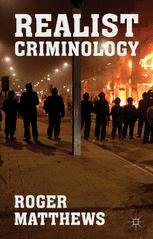
Realist Criminology PDF
Preview Realist Criminology
Realist Criminology This Page Intentionally Left Blank Realist Criminology Roger Matthews Professor of Criminology, University of Kent, UK © Roger Matthews 2014 Softcover reprint of the hardcover 1st edition 2014 978-1-137-44569-8 All rights reserved. No reproduction, copy or transmission of this publication may be made without written permission. No portion of this publication may be reproduced, copied or transmitted save with written permission or in accordance with the provisions of the Copyright, Designs and Patents Act 1988, or under the terms of any licence permitting limited copying issued by the Copyright Licensing Agency, Saffron House, 6–10 Kirby Street, London EC1N 8TS. Any person who does any unauthorized act in relation to this publication may be liable to criminal prosecution and civil claims for damages. The author has asserted his right to be identified as the author of this work in accordance with the Copyright, Designs and Patents Act 1988. First published 2014 by PALGRAVE MACMILLAN Palgrave Macmillan in the UK is an imprint of Macmillan Publishers Limited, registered in England, company number 785998, of Houndmills, Basingstoke, Hampshire RG21 6XS. Palgrave Macmillan in the US is a division of St Martin’s Press LLC, 175 Fifth Avenue, New York, NY 10010. Palgrave Macmillan is the global academic imprint of the above companies and has companies and representatives throughout the world. Palgrave® and Macmillan® are registered trademarks in the United States, the United Kingdom, Europe and other countries. ISBN 978-1-137-44570-4 ISBN 978-1-137-44571-1 (eBook) DOI10.1057/9781137445711 This book is printed on paper suitable for recycling and made from fully managed and sustained forest sources. Logging, pulping and manufacturing processes are expected to conform to the environmental regulations of the country of origin. A catalogue record for this book is available from the British Library. A catalog record for this book is available from the Library of Congress. For Jock This Page Intentionally Left Blank Contents List of Figures i x Preface x Acknowledgements x i 1 The Successes and Failures of Modern Criminology 1 The birth of modern criminology 1 Radical and critical criminology 5 The impact of feminist criminology 9 Administrative, pragmatic and managerialist criminologies 1 2 The contours of right realism and conservative criminology 1 5 The dimensions of liberal criminology 18 The failure of criminology and the need for critical realism 2 6 2 A Framework of Analysis 28 From left realism to critical realism 28 The primacy of theory 29 The significance of social class 32 Crime as a social construction 35 The structure and agency debate 38 Working in and against the state 41 Power 43 Defending human rights 46 I ntervention: beyond ‘what works’ 48 Conclusion 50 3 The Problem of Method 52 Engaging with social reality 52 Beyond cookbook criminology 53 The lure of empiricism 55 On causality 58 Voodoo criminology? 60 Ethnography 63 Doing realist research 67 Conclusion 70 vii viii Contents 4 Rational Choice, Routine Activities and Situational Crime Prevention 72 The new criminologies of everyday life 72 Routine activities theory 75 Preventing terrorism? 78 Is it a theory? 80 Cultural wars 84 Predictably irrational 85 Freakonomics and the crime drop 87 Assessing the utility of rational choice theory 90 Conclusion 92 5 From Cultural Criminology to Cultural Realism 9 4 The cultural turn 94 The contribution of cultural criminology 94 A realist response 97 Defending and reconstructing cultural criminology 1 03 In search of cultural realism 111 Conclusion 115 6 The Myth of Punitiveness Revisited 117 The problem of definition 117 Missing the punitive turn? 1 19 Engaging with the counterfactual 120 Changing public attitudes 132 Conclusion 134 7 Governing the Present 138 Governing through crime? 138 Domestic abuse 140 The criminalisation of schools 141 The changing social and political significance of crime 1 46 The shift towards pre-crime and security 147 Anti-social behaviour, incivilities and disorder 148 Governing through health and lifestyle 149 The changing nature of governance 152 Conclusion 153 References 1 56 Index 1 77 List of Figures 6.1 The levelling of the prison population in America 1 21 6.2 Adult correctional population on probation, in jail or in prison, or on parole, 1980–2010 1 24 6.3 Number of state prisoners by offence, 1980–2009 1 26 6.4 State expenditures by function in the United States 1 31 ix
